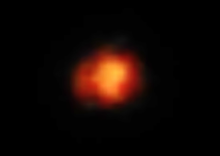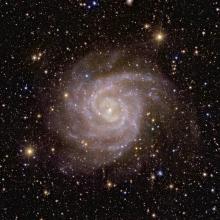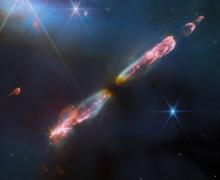Listen to today's episode of StarDate on the web the same day it airs in high-quality streaming audio without any extra ads or announcements. Choose a $8 one-month pass, or listen every day for a year for just $30.
You are here
IRS 7
The constellation Sagittarius climbs low across the south on summer evenings. Its brightest stars form the outline of a teapot. The center of the Milky Way galaxy lies just above the spout of the teapot, about 27,000 light-years away. That region is home to the Milky Way’s biggest black hole -- and also a big red star that looks like a comet.
Unfortunately, we see almost no visible light from the galactic center because the Milky Way is quite dusty. But infrared light, whose waves are longer than those of visible light, penetrates the dust.
Of all the stars near the black hole, the brightest at infrared wavelengths is IRS 7, with IRS standing for “infrared source.” The star is big, red, and cool. It’s a red supergiant, like beautiful Antares in Scorpius, the constellation to the west of Sagittarius. And it’s only about one light-year from the black hole.
Recent observations indicate the star is 20 to 25 times as massive as the Sun, and about a thousand times larger. If put in place of the Sun, it would engulf Mercury, Venus, Earth, and Mars, and almost reach Jupiter.
Although IRS 7 is a star, it has a tail that resembles a comet. The tail is at least half a light-year long. Like the Sun, IRS 7 emits a “wind” of charged particles. It comes off the star in all directions. But winds from the stars around it push IRS 7’s own wind, sculpting it into a tail that makes the star resemble an overgrown comet.
Script by Ken Croswell





